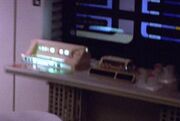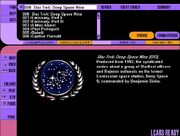m (→Background information: fm) |
|||
| Line 36: | Line 36: | ||
In the first two seasons of ''The Next Generation'', large black rectangles are clearly visible on the LCARS displays on the bridge (and sometimes in main engineering). This was a result of the studio lights reflecting off the displays, which director of photography [[Edward R. Brown]] tried to solve by sticking cardboard onto them. When Brown was replaced by [[Marvin V. Rush]] for the third season, a number of changes in filming (including better film stock and a smaller number of lights) allowed the LCARS displays to be seen properly. {{eas|inconsistencies/curiosities.htm}} |
In the first two seasons of ''The Next Generation'', large black rectangles are clearly visible on the LCARS displays on the bridge (and sometimes in main engineering). This was a result of the studio lights reflecting off the displays, which director of photography [[Edward R. Brown]] tried to solve by sticking cardboard onto them. When Brown was replaced by [[Marvin V. Rush]] for the third season, a number of changes in filming (including better film stock and a smaller number of lights) allowed the LCARS displays to be seen properly. {{eas|inconsistencies/curiosities.htm}} |
||
| + | |||
| + | The interface was updated for {{s|PIC}} by a team that included screenwriter [[Martin Garner]], creative director [[Chris Kieffer]], and designer [[Andrew Jarvis]]. [https://twitter.com/RJ_MacReady31/status/1220751387434213376] |
||
=== Apocrypha === |
=== Apocrypha === |
||
Revision as of 00:02, 25 January 2020
(covers information from several alternate timelines)

The crew of the Enterprise-E view LCARS display terminals on the bridge in 2379
The Library Computer Access and Retrieval System (LCARS for short) was a computer subsystem which was employed by the United Federation of Planets as the primary method of interacting with and operating a computer, including the library computer. It was used aboard Starfleet vessels, starbases, and space stations. (TNG: "Encounter at Farpoint", "The Vengeance Factor", "Conundrum", "Second Chances", "Future Imperfect")
LCARS was accessible virtually anywhere in a facility or starship by both voice and keypad commands via control interfaces. These interfaces included bridge stations, consoles, PADDs, tricorders, and desk computers. Typically, these were graphical controls housed underneath touch-sensitive clear panels that could be quickly reconfigured by users to suit the task at hand. There were also tactile interfaces for visually-impaired officers. (TNG: "Encounter at Farpoint", "The Vengeance Factor", "The Host", "Half a Life"; VOY: "Year of Hell")
LCARS used sophisticated subroutines in order to understand and execute vocal natural language commands. This enabled even complicated tasks to be executed with just a few commands in the case of voice or button presses in the case of keypad commands. LCARS controlled the retrieval and storage of files in the data banks housed within the ship's computer cores including logs like personal logs or transporter logs, element and chemical compound data and data on archaeological artifacts. (TNG: "Contagion", "Dark Page", "Man of the People", "Night Terrors", "Qpid") It was used to retrieve files in external databases like when a ship needs to assess traffic control around starbases or investigate inventory databases of surplus depots. (TNG: "Birthright, Part II", "Unification I") It was also used for command system access and for viewing the crew manifest. (TNG: "Brothers", "Conundrum") It was also used to display recently recorded data like medical scans, tactical scans and sensor scans. (TNG: "Ethics", "Interface", "Descent", "Relics", "Genesis") It displayed results of analyses like linguistic analyses, configuration analyses of system networks, and magnetic flux density analyses. (TNG: "Masks", "Attached", "Power Play")
LCARS controls aboard the Enterprise-E in 2379
Depending on the starship, the LCARS design, especially the color scheme, differed. These colors could range from a yellow/white (found on the USS Enterprise-D) to blue/white scheme (found on the USS Enterprise-E). (TNG: "Contagion", "Dark Page", "Man of the People", "Night Terrors", "Qpid"; Star Trek Nemesis)
In the alternate timeline of the Anti-time future around 2395, LCARS was still used and similar in appearance to its mid-24th century version. (TNG: "All Good Things...")
In an alternate timeline, by the 25th century, LCARS was further upgraded with three-dimensional control interfaces. (DS9: "The Visitor")
By the 29th century the LCARS was, at least partially, replaced by the TCARS. (VOY: "Relativity")
In the alternate reality, in the 2250s, PCAP was the equivalent of LCARS. (Star Trek; Star Trek Into Darkness)
Appendices
Related topics
Background information
LCARS interfaces are seen in almost every episode of Star Trek: The Next Generation, Star Trek: Deep Space Nine, and Star Trek: Voyager. The interfaces seen in Star Trek: The Original Series and Star Trek: Enterprise are never named and their designs are quite different.
A close-up view of one of the science stations aboard the Enterprise-D in "The Vengeance Factor" has the label "Library Computer Subsystems". [1] The full name "Library Computer Access and Retrieval System" can be seen in several episodes, including "The Price", "The Measure Of A Man" and "Conundrum". The phrase "library computer access and retrieval" is spoken in "Encounter at Farpoint")

TNG-style LCARS displays in Star Trek V: The Final Frontier
The sickbay used in Star Trek V: The Final Frontier is a minor redress of the TNG sickbay, and the LCARS panels on the wall are barely altered, so this could be the first LCARS appearance. They also appear in Star Trek VI: The Undiscovered Country just below the warp core, but they do not appear in the 23rd century portion of Star Trek Generations.
According to a Next Generation episode text commentary by Michael and Denise Okuda, the LCARS displays were rarely actual computer simulations; one such example was the computer screen used by Romulan Commander Sela to monitor the Federation fleet during her attempt to smuggle weapons and supplies to Lursa and B'Etor during the Klingon civil war in the episode "Redemption II". This was due, according to the Okudas, to both the high cost and primitive state of computer graphics in the late 1980s and early 1990s. Therefore, most LCARS displays were, in fact, plastic panels with spinning light devices behind them to give the impression that the information on the "displays" was changing.
In the first two seasons of The Next Generation, large black rectangles are clearly visible on the LCARS displays on the bridge (and sometimes in main engineering). This was a result of the studio lights reflecting off the displays, which director of photography Edward R. Brown tried to solve by sticking cardboard onto them. When Brown was replaced by Marvin V. Rush for the third season, a number of changes in filming (including better film stock and a smaller number of lights) allowed the LCARS displays to be seen properly. [2]
The interface was updated for Star Trek: Picard by a team that included screenwriter Martin Garner, creative director Chris Kieffer, and designer Andrew Jarvis. [3]
Apocrypha

LCARS as seen in the DS9 CD Companion
The LCARS layout has been used in several computer games and applications such as the CD-ROM version of the Star Trek Encyclopedia, as well as the TNG and DS9 CD-ROM Companions. The LCARS layout is also used on the Star Trek PADD app for the Apple iPad.
